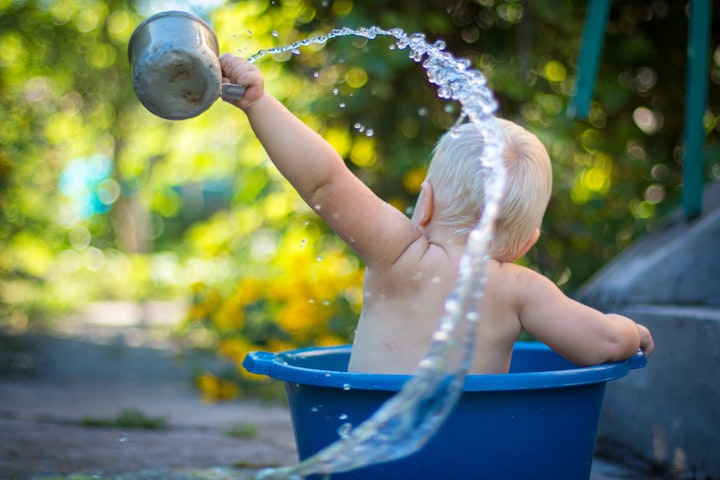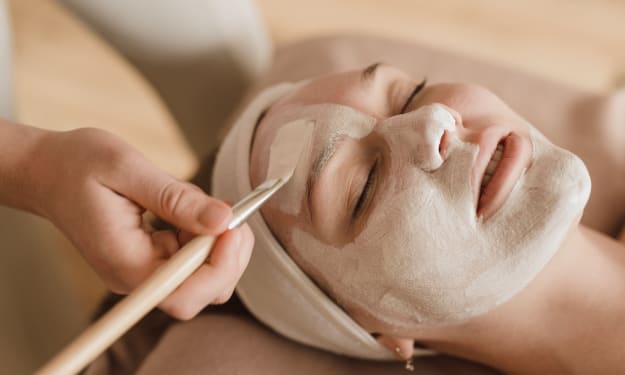The Evolution of Bathing Practices Across Lifespans"
"From Splash to Serenity:

In various cultures and traditions, bathing rituals and practices may hold symbolic meanings. The specific significance assigned to bathing from different body parts can vary widely depending on cultural, religious, or personal beliefs. Here are a few examples:
1. Head-first Bathing: In some cultures, starting the bathing process by washing the head is believed to cleanse the mind, promote clarity of thought, and remove negative energies. It is seen as a way to refresh and rejuvenate the mind and prepare oneself for the day ahead.
2. Feet-first Bathing: Bathing from the feet upward is practiced in certain traditions as a way to symbolically ground and purify oneself. It is believed to wash away the fatigue and negativity accumulated throughout the day and promote a sense of stability and balance.
3. Handwashing Rituals: Handwashing rituals hold significance in many cultures and religions. For example, in some religious practices, handwashing before prayer is seen as a symbolic act of purification and preparation for engaging in a sacred activity. Handwashing can also be seen as a way to cleanse oneself physically and spiritually.
4. Chest or Heart Area: Bathing or washing the chest or heart area may hold symbolic meaning related to emotional cleansing, renewal, or self-reflection. It can be associated with letting go of emotional burdens, opening oneself up to love and compassion, or seeking inner peace and balance.
It's important to note that the meanings attributed to bathing practices can vary greatly, and they are subjective to personal beliefs and cultural contexts. Different cultures and individuals may have their own unique interpretations and rituals associated with bathing. It's always best to refer to specific cultural or religious practices if you are seeking a more detailed understanding of the symbolism behind bathing rituals in a particular context.
In general, bathing is regarded as a cleansing and refreshing activity that promotes hygiene and physical well-being. Whether you choose to follow specific bathing rituals or simply adopt a routine that makes you feel comfortable and clean, the most important aspect is to prioritize your personal hygiene and maintain a healthy self-care practice.
Taking a bath regularly offers several benefits for personal hygiene, health, and well-being. Here are some of the key advantages:
1. Cleansing and Hygiene: Bathing helps to cleanse the body by removing dirt, sweat, bacteria, and dead skin cells. It helps maintain personal hygiene and prevents body odour.
2. Skin Health: Regular bathing can improve skin health by keeping it clean, moisturized, and free from impurities. It can help prevent acne, rashes, and other skin infections.
3. Relaxation and Stress Relief: Bathing can be a relaxing and rejuvenating experience, particularly when combined with warm water and aromatic bath products. It can help reduce stress, promote relaxation, and improve overall mood.
4. Muscle Relaxation: Immersing yourself in a bath can provide relief for tired, sore muscles and promote relaxation. Warm water can help ease muscle tension, reduce inflammation, and alleviate minor aches and pains.
5. Improved Sleep: Taking a bath before bedtime can promote better sleep. The warm water and relaxation can help calm the body and mind, making it easier to fall asleep and enjoy a more restful night.
6. Respiratory Health: Bathing in warm water can create a steamy environment, which can be beneficial for respiratory health. The steam can help loosen congestion, open up nasal passages, and provide temporary relief from respiratory conditions like colds, allergies, and sinusitis.
7. Blood Circulation: Bathing in warm water causes blood vessels to dilate, improving blood circulation throughout the body. This increased blood flow can promote better oxygenation of tissues and organs, and overall cardiovascular health.
8. Improved Mental Well-being: Taking a bath can have a positive impact on mental well-being. It offers a tranquil and private space where one can relax, reflect, and unwind, providing a break from daily stressors and promoting a sense of calmness and self-care.
It's important to note that the frequency and duration of bathing may vary depending on individual preferences, climate, and personal circumstances. It's generally recommended to maintain good personal hygiene by bathing regularly, but the specific routine can be tailored to personal needs and preferences.
Which is the best to use for bathing hot or cold water?
The choice between hot and cold water for bathing is largely a matter of personal preference and can depend on various factors such as climate, individual tolerance, and desired effects. Here are some considerations for both hot and cold water baths:
Hot Water Bath:
1. Relaxation: Hot water has a soothing effect on the body and can help relax muscles and relieve tension. It can be especially beneficial after a strenuous workout or a long day.
2. Improved Circulation: The heat from a hot water bath can cause blood vessels to dilate, promoting better blood circulation throughout the body.
3. Sinus Relief: Steam from a hot water bath can help alleviate congestion and open up nasal passages, providing temporary relief from respiratory conditions like colds or sinusitis.
4. Pain Relief: The warmth of a hot water bath can help ease minor aches, pains, and muscle soreness.
Cold Water Bath:
1. Refreshment: Cold water baths can provide a cooling and invigorating sensation, especially during hot weather or after intense physical activity.
2. Reduced Inflammation: Cold water can help reduce inflammation, swelling, and redness in the body, making it beneficial for certain skin conditions or muscle injuries.
3. Increased Alertness: Cold water baths can stimulate the body and mind, promoting wakefulness and alertness. Some people find it helpful in starting their day with a burst of energy.
4. Muscle Recovery: Cold water baths may aid in muscle recovery after intense exercise or sports activities by reducing muscle inflammation and speeding up the recovery process.
Ultimately, the choice between hot and cold water for bathing depends on personal preference and the desired effect. Some individuals may prefer alternating between hot and cold water or experimenting with different temperatures to enjoy a combination of benefits. It's important to listen to your body, consider any specific health conditions or sensitivities you may have, and adjust the water temperature accordingly to ensure your comfort and well-being.
Bathing practices can vary depending on the age and specific needs of individuals. Here are some considerations for bathing at different stages:
1. Children:
• Supervision: Young children should always be supervised during bath time to ensure their safety.
• Water Temperature: The water should be comfortably warm, around 37-38°C (98-100°F), to avoid scalding or chilling the child.
• Gentle Cleansing: Use mild, child-friendly soap or cleansers to clean their delicate skin. Avoid using harsh chemicals or excessive scrubbing.
• Bath Toys: Bath time can be made fun with the use of child-safe bath toys to engage and entertain children.
• Duration: Keep bath time relatively short to prevent overexposure to water and to maintain the child's comfort.
2. Adults:
• Water Temperature: Adults can choose the water temperature based on personal preference. Warm water is commonly preferred for relaxation.
• Cleansing Products: Use suitable soaps or body washes that suit your skin type and preferences.
• Exfoliation: Adults may incorporate gentle exfoliation to remove dead skin cells. However, it's important to avoid excessive scrubbing, which can irritate the skin.
• Hair Care: Properly cleanse and condition the hair according to individual needs.
• Duration: Bathing time can vary, but typically 10-20 minutes is sufficient for most adults.
3. Older Adults:
• Safety: Older adults may have reduced mobility and increased fall risk. Ensure the bathroom is safe, with grab bars, non-slip mats, and good lighting.
• Water Temperature: Warm water is generally preferred, but it should be comfortably warm to avoid burns or dizziness.
• Assistance: Some older adults may require assistance with bathing due to mobility issues. Caregivers or family members may need to provide support as needed.
• Skin Care: Older adults may have more delicate skin. Use mild, moisturizing cleansers and apply lotion afterward to prevent dryness.
• Duration: Older adults may prefer shorter bathing durations to prevent fatigue or discomfort. Ensure they have enough time to complete their bathing routine safely.
It's important to note that these guidelines are general considerations, and individual preferences and specific needs should always be taken into account. Consulting with healthcare professionals or caregivers can provide personalized recommendations for bathing practices at different stages of life.
About the Creator
ADEBAYO ADELEYE J
I have a strong passion for writing and Over the past 3 years, I have honed my writing abilities through various projects, including relevant writing experiences, such as freelance work, published articles, or blog contributions.





Comments
There are no comments for this story
Be the first to respond and start the conversation.